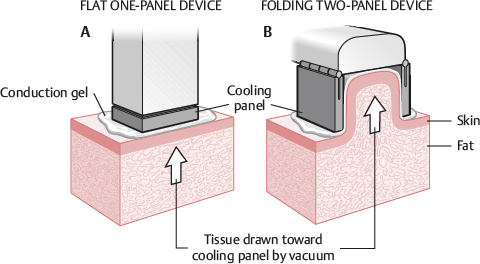64. Noninvasive Body Contouring
Michael Bykowski, Derek Ulvila, Spero J. Theodorou, Christopher T. Chia
PREOPERATIVE EVALUATION
■ History of weight loss and gain; type of exercise routine and current diet regimen, if any
■ History of skin laxity disorders and previous procedures
■ Physical examination: Pinch test, caliper measurement, skin laxity, body mass index, visceral fat assessment
INFORMED CONSENT
■ Expectations of minor procedural discomfort and postprocedural erythema/edema
■ The risk of temporary sensory deficits: Numbness and hyperesthesia
■ The potential for undercorrection or overcorrection of fat areas, possible contour deformities, and overlying skin changes; no guarantee of aesthetic outcome
METHODS OF NONOPERATIVE TREATMENT
■ Cryolipolysis (e.g., CoolSculpting)
■ High-intensity focused ultrasound (HIFU) (e.g., Liposonix)
■ Low-level laser therapy (e.g., Zerona)
■ Radiofrequency energy (e.g., Vanquish)
CRYOLIPOLYSIS
■ Application of cooling panels to localized areas of adiposity resulting in apoptosis-mediated cell death and subsequent inflammatory response.1
■ Preclinical studies showed 33% reduction in thickness of superficial fat layer2 with maximal relative loss of nearly 80%.1
■ A systematic review of human studies showed average reduction in caliper measurement of 14.7%-28.5% and average reduction by ultrasound 10.3%-25.5%.3
SENIOR AUTHOR TIP: Changes seen as early as 3 weeks after treatment but most dramatic results seen after 2 months.
Indications
■ Treatment of visible fat bulges of the submental area, upper arm, bra line fat, back fat, abdomen, flank, banana roll, and thighs in individuals with a body mass index (BMI) <30
Contraindications
■ Pregnancy
■ History of cold-induced dermatologic syndromes (e.g., cryoglobulinemia, paroxysmal cold hemoglobinuria, or cold urticaria)
■ Large-volume weight loss in obese patients
■ Patients with excessive skin laxity
Equipment
■ Cooling applicator with attached mild vacuum
■ One- or two-panel devices can be used (Fig. 64-1).

Fig. 64-1 Various cryolipolysis applicators are available to contour to specific anatomic areas. A, Flat applicator for relatively flat surfaces (e.g., back or inner thigh). B, Concave applicator for curved surfaces (“muffin top” or “love handles”).
■ Conduction gel applied between cooling device and treatment area
Technique
■ Markings: Markings depend on specific anatomic structure and focal area of adiposity.
■ Conduction gel is placed on the area to be treated.
■ Tissue is drawn into the cooling panel with the vacuum to create a seal (see Fig. 64-1).
■ Cooling panels are set to an energy extraction rate ~60-70 mW/cm2 and held in place for 30-60 minutes’ exposure time.
TIP: Temperature and time of application are both important to induce selective cryolipolysis of fatty tissue.
Postoperative Care
■ Postoperative dressings are not needed but may be applied for patient comfort.
■ Topical and oral analgesics are used as needed.
Complications
■ Minor
• Minor discomfort during procedure4
• Temporary (several days) edema and/or erythema to treated area1,4
• Temporary (1-6 weeks) decreased light-touch sensitivity, temperature sensitivity, pain sensitivity to treated area4
■ Major
• Paradoxical adipose hyperplasia (incidence: 0.52%).5
• 100% of patients had erythema, which resolved within 1 week.
• 67% of patients developed postprocedural sensory deficits to treated area (all deficits were resolved by 2 months).4
■ Common treatments
• Pain is adequately controlled with topical and oral analgesics.
• All minor complications are self-limited.
HIGH-INTENSITY FOCUSED ULTRASOUND (HIFU)
■ High-intensity focused ultrasound is focused energy used to thermally ablate subcutaneous adipose tissue and to induce neocollagenesis.
■ HIFU increases the local temperature within the midlamellar fat layer leading to coagulative necrosis of adipocytes and subsequent reduction of fat layer.
• Two case series have been reported of 282 and 85 patients treated with HIFU to the abdomen and flank resulting in an average waist circumference decrease of 4.4 and 4.7 cm, respectively.6,7
• A multicenter, randomized, sham-controlled, single-blinded trial of 180 patients studying HIFU in trunk aesthetics showed a decrease of 2.5 cm in the treatment group compared with 1.2 cm in the sham group.8
• A multicenter, randomized, nonblinded study of 118 patients treated with a single HIFU treatment to the abdomen resulted in a decrease of 2.3 cm in waist circumference.9
SENIOR AUTHOR TIP: Results typically seen 8-12 weeks after treatment.
Stay updated, free articles. Join our Telegram channel

Full access? Get Clinical Tree




